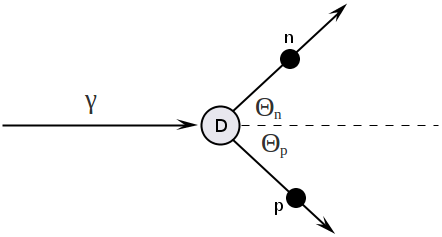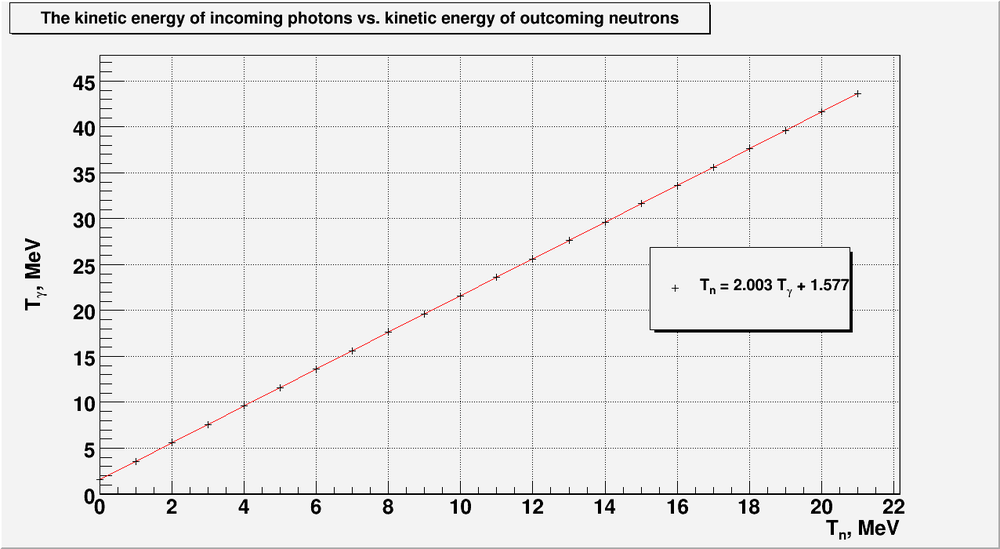Difference between revisions of "Neutron Polarimeter"
| Line 105: | Line 105: | ||
| − | Say, we have 10 MeV neutron, 1.5 m away detector, and neutron's time of flight uncertainty is <math>1\ ns</math>. | + | Say, we have 10 MeV neutron, 1.5 m away detector, and neutron's time of flight uncertainty is <math>1\ ns</math>. |
| + | |||
| + | |||
| + | |||
| + | Using the formulas above we can find: | ||
<math>t(T_n = 10\ MeV) = 35\ ns</math> | <math>t(T_n = 10\ MeV) = 35\ ns</math> | ||
| − | |||
| − | |||
<math>\delta T_n(\delta t = 1\ ns) = 0.59\ MeV</math> | <math>\delta T_n(\delta t = 1\ ns) = 0.59\ MeV</math> | ||
| Line 121: | Line 123: | ||
| − | Below are some | + | Below are some calculations for different neutron energy based on time flight uncertainty <math>1\ ns</math>: |
| − | {| height="10" border="1" cellpadding=" | + | {| height="10" border="1" cellpadding="12" cellspacing="1" |
|- | |- | ||
|<math>\delta t_n</math> | |<math>\delta t_n</math> | ||
| Line 134: | Line 136: | ||
|<math>\delta T_{\gamma}</math> | |<math>\delta T_{\gamma}</math> | ||
|<math>\frac{\delta T_{\gamma}}{T_{\gamma}}</math> | |<math>\frac{\delta T_{\gamma}}{T_{\gamma}}</math> | ||
| + | |- | ||
| + | |1 ns||1.5 m||0.1 MeV||0.015||343 ns||0.0006 MeV||0.6 %||0.0012 MeV||0.07 % | ||
|- | |- | ||
|1 ns||1.5 m||0.5 MeV||0.033||153 ns||0.006 MeV||1.3 %||0.013 MeV||0.5 % | |1 ns||1.5 m||0.5 MeV||0.033||153 ns||0.006 MeV||1.3 %||0.013 MeV||0.5 % | ||
|- | |- | ||
| − | |1 ns||1.5 m||1.0 MeV||0.046||108 ns||0.02 MeV||1. | + | |1 ns||1.5 m||1.0 MeV||0.046||108 ns||0.02 MeV||1.9 %||0.04 MeV||1.0 % |
|- | |- | ||
| − | |1 ns||1.5 m||2.0 MeV||0.065||77 ns||0.05 MeV||2.6 %||0. | + | |1 ns||1.5 m||2.0 MeV||0.065||77 ns||0.05 MeV||2.6 %||0.11 MeV||1.9 % |
|- | |- | ||
|1 ns||1.5 m||5.0 MeV||0.103||49 ns||0.21 MeV||4.1 %||0.41 MeV||3.6 % | |1 ns||1.5 m||5.0 MeV||0.103||49 ns||0.21 MeV||4.1 %||0.41 MeV||3.6 % | ||
| Line 145: | Line 149: | ||
|1 ns||1.5 m||10.0 MeV||0.145||35 ns||0.59 MeV||5.9 %||1.18 MeV||5.5 % | |1 ns||1.5 m||10.0 MeV||0.145||35 ns||0.59 MeV||5.9 %||1.18 MeV||5.5 % | ||
|- | |- | ||
| − | |1 ns||1.5 m||20.0 MeV||0.203||25 ns||1. | + | |1 ns||1.5 m||20.0 MeV||0.203||25 ns||1.68 MeV||8.4 %||3.36 MeV||8.1 % |
|} | |} | ||
Revision as of 03:18, 6 April 2011
Four-vector Algebra
Consider the two bode reaction :
Write down all four-vectors:
Now apply the conservation of four-momentum:
Squaring both side of equation above and using the four-momentum invariants we have:
Detector located at case
Detector is located at , and the formula above is simplified:
We can easily solve the equation above with respect to incident photon energy:
For non-relativistic neutrons and the formula above is become:
Substituting the corresponding masses, we get finally:
and visa versa:
Here I derived the formula [2] just inversing the formula [1]. I can as well start from exact solution above, solve this equation with respect to neutron energy, do the non-relativistic approximation and get exactly the same formula [2]. But anyway we ended up with two useful non-relativistic formulas we can analyze now:
1) from formula [1] above we can predict the threshold of reaction in direction:
2) from formula [1] above we can predict the incident photon energy based on the detected neutron energy (neutron polarimeter).
3) from formula [2] above we can predict the detected neutron energy based on the incident photon energy.
- for the incident photons up to we can detect neutrons up to
- for the incident photons up to we can detect neutrons up to
4) we can do the error calculations.
Example of error calculation (need to be checked)
example 1
Say, we have, 10 MeV neutron with uncertainty 1 MeV, the corresponding uncertainly for photons energy is:
example 2
In the calculations below I attempted to predict the uncertainty in photons energy based on uncertainly of neutrons time of flight.
Say, the neutron's time of flight uncertainty is:
The neutron kinetic energy is:
By taking derivative of the expression above we can find the relative neutron energy error:
Also we need to know the neutron time of flight as function of the neutron energy:
Say, we have 10 MeV neutron, 1.5 m away detector, and neutron's time of flight uncertainty is .
Using the formulas above we can find:
Below are some calculations for different neutron energy based on time flight uncertainty :
| 1 ns | 1.5 m | 0.1 MeV | 0.015 | 343 ns | 0.0006 MeV | 0.6 % | 0.0012 MeV | 0.07 % |
| 1 ns | 1.5 m | 0.5 MeV | 0.033 | 153 ns | 0.006 MeV | 1.3 % | 0.013 MeV | 0.5 % |
| 1 ns | 1.5 m | 1.0 MeV | 0.046 | 108 ns | 0.02 MeV | 1.9 % | 0.04 MeV | 1.0 % |
| 1 ns | 1.5 m | 2.0 MeV | 0.065 | 77 ns | 0.05 MeV | 2.6 % | 0.11 MeV | 1.9 % |
| 1 ns | 1.5 m | 5.0 MeV | 0.103 | 49 ns | 0.21 MeV | 4.1 % | 0.41 MeV | 3.6 % |
| 1 ns | 1.5 m | 10.0 MeV | 0.145 | 35 ns | 0.59 MeV | 5.9 % | 1.18 MeV | 5.5 % |
| 1 ns | 1.5 m | 20.0 MeV | 0.203 | 25 ns | 1.68 MeV | 8.4 % | 3.36 MeV | 8.1 % |

